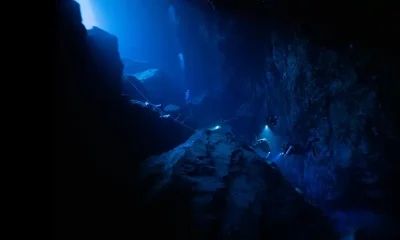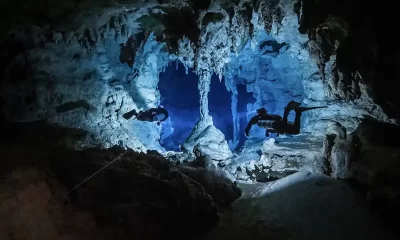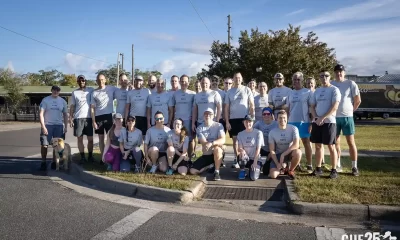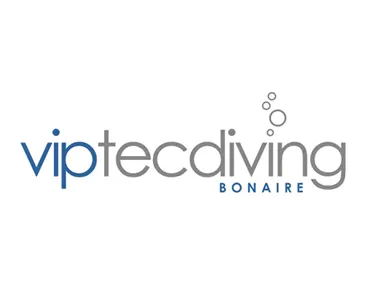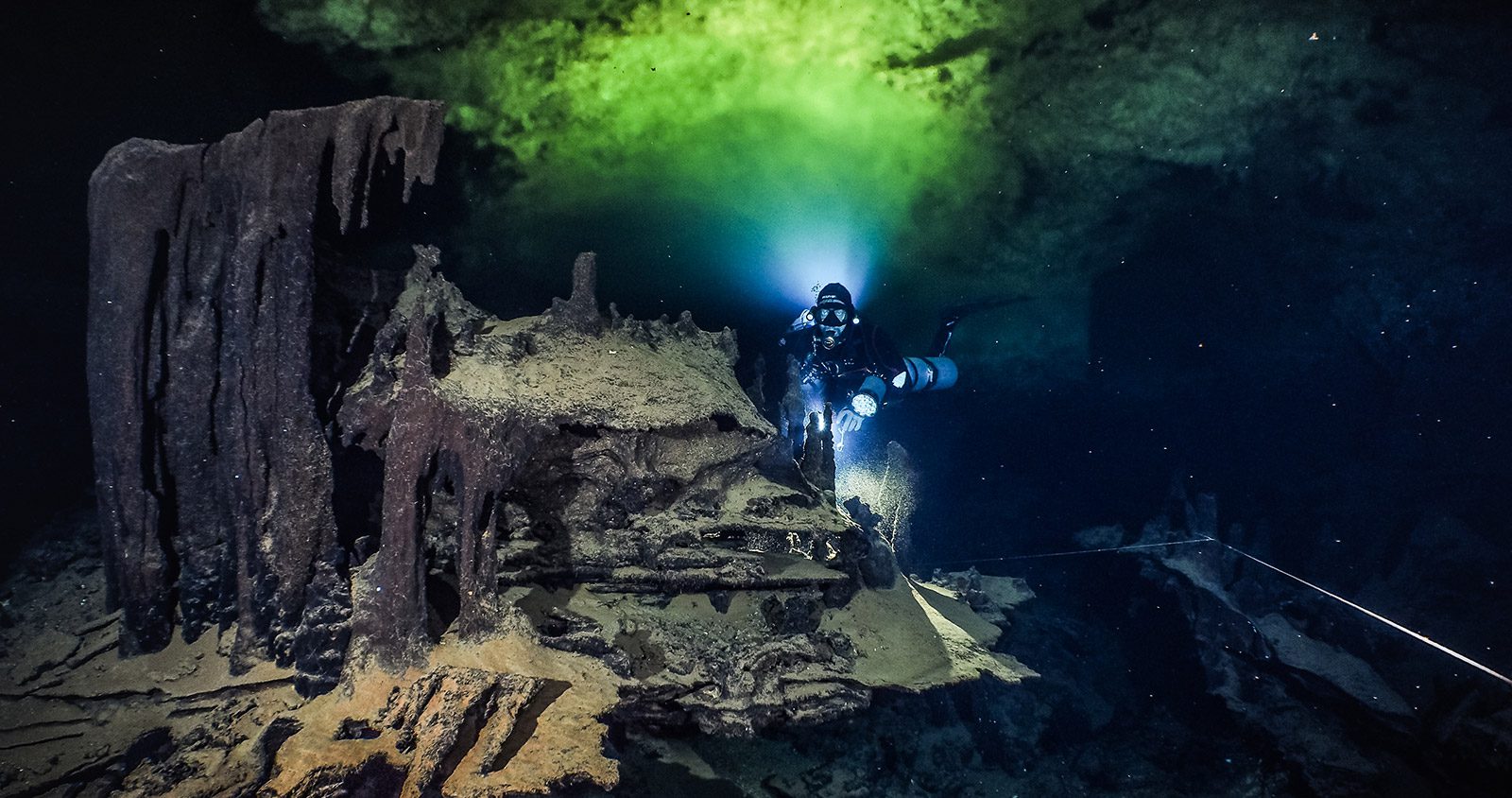
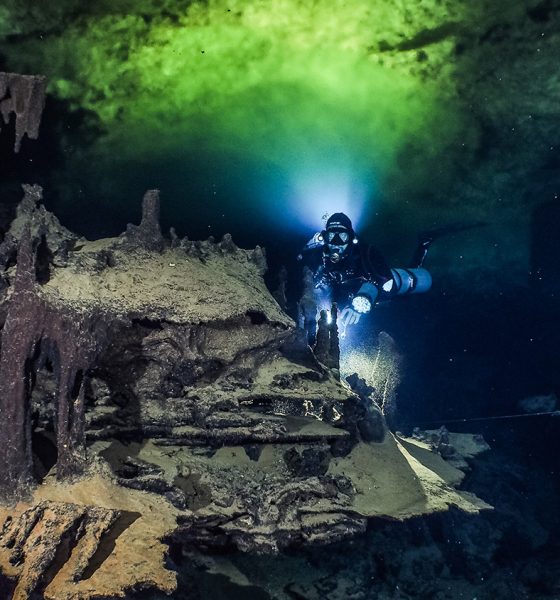
Exploration
Laying Line in Cozumel
While tech divers thrill in the joys of mixed gas, reef drift diving, Rob Neto and his team continue to plumb the Cozumel underground, emptying their reels in newly discovered La Sección Escondido, la Cueva Quebrada, Aerolito, and a newly discovered cave that they’re keeping to themselves for now. Neto says there are tens of thousands of kilometers of passageway left to go! We also include a look at the Cozumel Underground nearly 30 years ago. Dive in!
by Rob Neto. Images courtesy of Laurent Miroult unless noted. Lead image: The author posing next to a large silt covered dripstone formation just below the halocline in la Sección Escondido.
| A blast from the past! Check out the state of Cozumel caves more than 30 years ago. COZUMEL UNDERGROUND by Michael Menduno |
Swimming through a passage large enough to drive a bus through with plenty of room to spare, I’m balancing my speed against my breathing rate. I could move faster, but that would only cause me to have to turn sooner, and I definitely don’t want to do that. I also still have to survey on the way out. It’s one of my rules for exploration – never lay more line than I can survey on the exit. Of course, there are exceptions, as with every rule. But none of them apply at the moment.
I’m laying line from my second exploration reel. Yep, number two, on that dive! There’s so much virgin passage it’s almost overwhelming. Each reel carries about 335 m/1100 ft of line. And the one in my hand, the second one, is almost empty. I can see a wall at the end of the passage, but the passage looks like it turns to the right. I think I should have enough line to make it a little beyond that turn. I’ll have to return to keep pushing the passage. As I approach the wall, I see what looks like an old cave line lying on the floor. I’m still too far from it to know for certain.
This is a saltwater cave, which means there is more life here than is found in the freshwater caves. So what I was seeing could be some sort of biological material. As I get closer, I notice what resembles a Dorf marker (named after Lewis Holzendorf who came up with the idea), the old duct tape line arrows that were common back in the 80s and 90s. My shoulders drop. The exploration of this passage has come to an end.
When most divers think of Cozumel, they think coral reefs and drift diving. Little do they know Cozumel, like Riviera Maya just across the channel, is home to numerous caves and the site of active exploration.
Finding Cenote Escondido
On that dive alone, I laid more than 600 meters/2000 feet of line. That’s in addition to more than 6000 meters/20,000 feet of line in that section since I first found it in 2015. The lead I found at that time brought me through a small bottle off sidemount restriction. It wasn’t a long traverse through the restriction, maybe ten feet. And once on the other side, the passage got wide and tall and went for miles/kilometers.
Along the way, about 450 m/1500 ft from the restriction, I found a cenote during a subsequent trip. Somehow, I had missed it when I first lined the passage. I guess I was so focused on pushing the passage I didn’t notice the debris, evidence of a cenote overhead, and the opening was small enough that a little rain produced sufficient tannins to darken the opening that day, so there was no daylight falling into the passage my first time through it. This time we were there during the dry season and daylight was penetrating the depths.

As I approached it, I saw the light ahead and thought to myself, who else could be down here in this cave? Then I realized it wasn’t the light from a diver, but the light from an opening that I was seeing. That’s when I noticed the leaves and tree branches strewn about on the floor of the passage. I covered my light and signaled to my buddy, Laurent Miroult (whose photos accompany this article). We stopped and I tied in a jump spool so we could surface. It was only 4.5 m/15 ft deep at this point. We surfaced in a small cenote that would fit one additional diver, as long as the three of us were very comfortable with each other.
The surface of the water was about 2 m/6 ft below the jungle’s floor. And there were no footholds to assist in getting in or out of this cenote. There was also no shelf to set our tanks on while we tried to climb out. We’d have to find this from the surface another time. We descended back into the cave and I did a quick survey, three stations each way, so I could pinpoint the location of the cenote on my map. I already had a name chosen for it – Cenote Escondido (Hidden Cenote). Laurent and I went back the next day to surface again while another team member searched the area from above. It took us about an hour to swim to the cenote from our entry point, so we coordinated the times and began our journey.
A little over an hour later we surfaced in Cenote Escondido and began yelling out for our teammate. About 15 minutes later, we heard him yelling back. It took him another 15-20 minutes to hack a path through the dense jungle to get to us. The cenote was even more hidden from above! He finally arrived, tired and sweaty, scratched up and bruised. He also had news of another cenote he had found as he was hacking his way through the jungle to the approximate waypoint derived by my survey (it’s since been named Cenote Catedral because of its cathedral-like appearance).
Now we had a waypoint, and we could form a direct path through the jungle to Cenote Escondido. This would allow us to cut an hour of swim time from our dives. We cut the path through the jungle, but we would need to hold off on beginning our dives at the new cenote until the next trip because we needed ropes and ladders to get to and from the water’s surface and to secure our cylinders at the surface.
Back to Cenote Escondido
Immediately upon returning to Cozumel a few months later we headed straight to Cenote Escondido and set up our equipment ropes and a couple of rope ladders we had brought with us to the island. Over the course of the next three days, I laid about 1700 m/5500 ft of line using that cenote as the starting point. Not only did entering through Cenote Escondido cut an hour of travel off the dive but it also put us right in the center of a cave explorer’s dream come true. Within 10 minutes of descending below the surface, we were laying line in virgin passage. This happened all three days! The last day was the day I finally looped back to the 35-year-old line with the old Dorf marker on it.
I follow the old line for about 45 m/150 ft before coming to an intersection that looks very familiar. In fact, it looks so familiar I am 99% sure where I am in the cave. I turn around and survey on the way out. That evening, back at the hacienda, I plot out my data and I end up right where I thought I was – only a 15-minute swim from another cenote we had accessed many times before. One of my previous team members had surveyed this area of the cave a couple of years prior. I had been to the intersection I recognized but didn’t go beyond it. Lesson learned – don’t just accept survey data from team members; go look at it for yourself!
So, two cave divers had both been to the end of the line, the one with the Dorf marker on it, and missed the larger-than-a-bus passage to the left of where it ended. I have to say I was very thankful for that because, had they noticed it, the passage wouldn’t have been there for me to discover and explore. Ok, so, yes, I found it from another location more than 900 m/3000 ft away as the fish swims. I aptly named the section that had been missed by at least two other divers la Sección Escondido, after the cenote.

La Sección Escondido currently measures approximately 10,500 m/35,000 ft in length. That’s 1900 m/6000 ft longer than the known extent of la Cueva Quebrada at the time of the original exploration and map. My team and I have laid much more line than that in other sections of Quebrada. This includes the connection between la Quebrada and Dos Coronas, which is now la Sección Dos Coronas of la Cueva Quebrada. See the article describing the connection we made in 2014.
Our explorations, along with explorations made by Steve and Judy Ormeroid in the late 2000s/early 2010s has resulted in la Cueva Quebrada currently measuring approximately 26,000 m/85,000 ft of lined and surveyed passage. And I’m not done yet. We still have ongoing exploration that we are certain will push the length of the system well over 30,000 m/100,000 ft. This makes la Cueva Quebrada the longest underwater cave system on the island of Cozumel and places it in the top ten for all underwater caves in Mexico. Our future explorations will go a bit easier because we now have DPVs on the island to facilitate travel time to the areas we are currently exploring.

Exploring Aerolito
In addition to our exploration in la Cueva Quebrada, we have also been resurveying and exploring Aerolito de Paraiso, the only cave on Cozumel that is publicly accessible. The original map of Aerolito reported 6000 m/20,000 ft of passage. Our explorations have increased that number to more than 7900 m/26,000 ft of lined passage as of 15 AUG 2023. And we are also still actively exploring Aerolitol. In fact, we are hopeful that we will be able to connect Aerolito to another cave on the island that we have been exploring.
This other cave was completely virgin prior to us finding it. There’s more than 940 m/3100 ft of line in that cave and the ongoing passage appears to be heading straight for Aerolito. There’s still some distance to be covered between the two caves, but we have located a possible access point along the way that we may use at some point. The island caves never stop surprising us.
The last couple of days haven’t provided quite the honeypot of virgin passage that we experienced at the beginning of the week. We might finally be nearing the end of our exploration efforts.

That’s been the thought on a few of the early trips to Cozumel in the past. I stopped having those thoughts long ago. I always have a knack for finding ongoing passage on the last dive of the trip. I even ran out of line on one of the early trips! Now I have an excess of line on the island. I’ll always have enough for at least two trips of diving. And the thoughts that I’ll ever be done exploring the passages that lie under the jungle are long gone. I’m certain I’ll be retiring from exploration and passing the reins to a younger generation before it’s fully explored. I’m already mentoring someone for that responsibility and honor.
In the meantime, I schedule the next trip before I even leave to return home from the trip I’m on. And anxious to get back to continue pushing the lead I found earlier in the day. Unfortunately, COVID slowed things down for a couple of years, but with that mess mostly behind us, we are now back strong and pushing the leads regularly again. I’m looking forward to when I can make the announcement that we’ve busted the 30,000 m/100,000 ft mark.

Thirty years ago, no one believed that Cozumel had caves. They were wrong. Here’s a brief dive into the Cozumel underground circa 1997.
DIVE DEEPER
YouTube: Aerolito de Paraiso by Rob Neto
Cozumel Caves: Cozumel’s Influence in Choosing a Sidemount Rig (2014) by Rob Neto
InDEPTH: Deep Drift Diving in Cozumel by Alberto Nava (2019)
InDEPTH: The Who’s Who of Sidemount: Rob Neto
Speaking Sidemount E062 – Rob Neto – The Almost Comprehensive Guide to Sidemount
BOOKS:Check out Neto’s debut novel: Beyond the Grate
Amazon.com: Sidemount Diving: The Almost Comprehensive Guide 2nd edition

Rob Neto is an experienced cave diver, explorer, and surveyor. He has been diving and exploring caves for 20 years and was a dive instructor for over 10 years. His current focus in diving is cave exploration and mapping, as well as traveling around the world to experience caves everywhere. When not exploring Rob focuses on documenting underwater caves with video and as a photography model. He has been cave diving in several countries and has ongoing exploration projects in the US, Mexico, and France, as well as assisting with a project in Italy. He primarily dives sidemount configuration due to the nature of his dives but also dives SCRs and CCRs when appropriate. Rob is the author of Sidemount Diving – The Almost Comprehensive Guide 2nd edition, as well as Beyond the Grate, a suspense thriller inspired by true events surrounding the disappearance of a diver last seen at a Florida panhandle spring where an underwater cave is located. He’s currently working on a sequel, Into the Darkness Beyond.




















